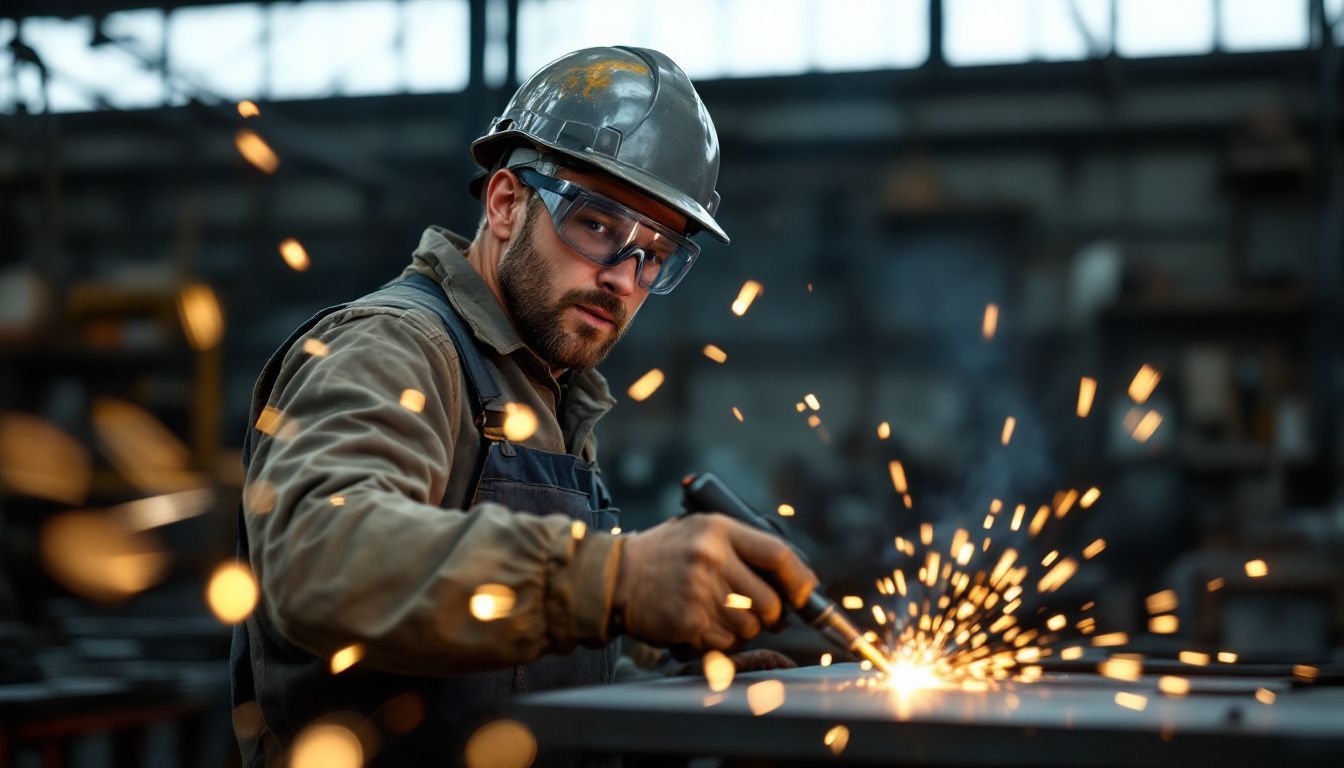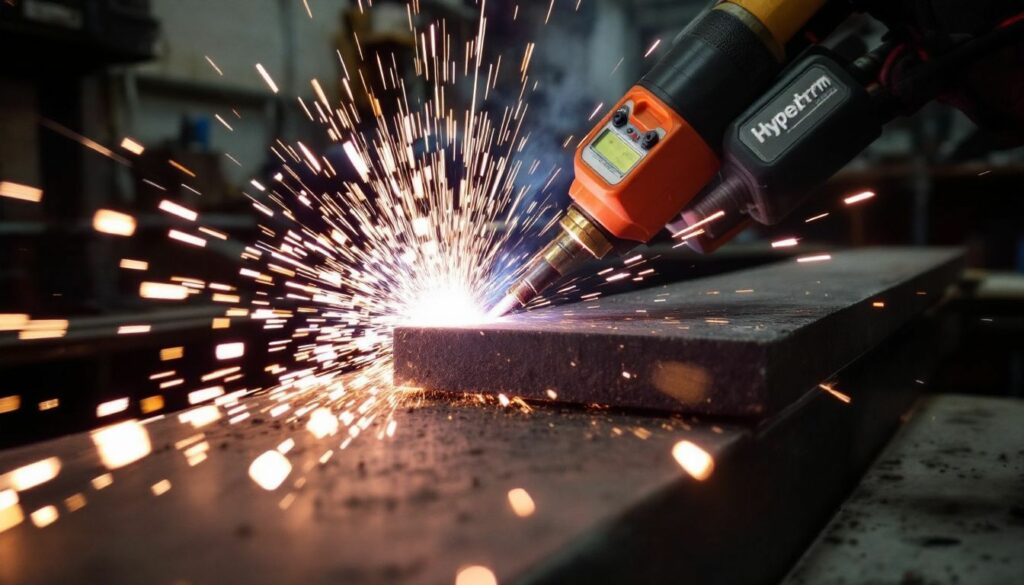Choosing the right plasma cutting machine can be challenging for your projects. Plasma cutting uses a hot plasma jet to quickly and precisely cut through metals like steel and aluminum.
This guide will help you understand plasma cutting and select the best Hypertherm plasma cutter for your needs. Find the perfect tool for your work today.
Key Takeaways
- Plasma cutting uses a hot plasma jet to quickly and precisely cut metals like steel and aluminum. It reaches temperatures up to 30,000°F and is used in industries such as fabrication and automotive repair.
- Hypertherm’s Powermax Series includes models like Powermax65 SYNC ($5,220), Powermax105 SYNC ($8,520), and Max Pro 200 ($21,925). These cutters offer different levels of power and precision for various project needs.
- Plasma cutters can handle metal thicknesses up to 38 mm (1.5 inches) handheld and up to 150 mm (6 inches) with industrial CNC torches. They are efficient and cost-effective but are less precise with thinner sheets.
- Key advantages include high-quality cuts, speed, and the ability to cut all conductive materials. Proper maintenance and safety practices, such as wearing protective gear and regular equipment inspections, are essential for safe and effective use.
What is Plasma Cutting?

Plasma cutting uses a plasma torch to direct a hot plasma arc. This arc cuts through metals like steel, stainless steel, aluminum, brass, and copper. The cutting process involves ionizing plasma gas to create a high-temperature jet.
An electric current flows from the torch through the gas and the metal, melting it quickly. Plasma cutters work efficiently in industries such as fabrication, automotive repair, and industrial construction.
They are valued for their speed, precision, and cost-effectiveness.
Plasma cutting provides a fast and exact way to shape metal, making it a favorite in many industries.
Next, let’s explore how plasma cutting works.
How Plasma Cutting Works
Understanding what plasma cutting is sets the stage for exploring how it operates. A plasma cutter creates an electrical channel of ionized gas from the cutter to the workpiece. This channel completes a circuit through a grounding clamp.
Compressed gas, such as oxygen or air, is blown through a nozzle at high speed. This forms an arc that cuts through the metal. Handheld torches can cut steel up to 38 mm (1.5 inches) thick.
Industrial CNC torches can handle materials up to 150 mm (6 inches) thick. The process starts with a high-voltage spark that ionizes the gas, turning it into plasma.
The plasma ejection melts the metal quickly and precisely. High-frequency current keeps the arc stable during cutting. CNC plasma cutters use numerical control to move the torch accurately.
This allows for detailed cuts on cutting tables. The intense heat from the plasma, reaching up to 30,000°F, melts the metal rapidly. Plasma cutting is efficient for thick metals and is widely used in metalworking and automobile repair shops.
The combination of high temperature and fast gas flow makes plasma arc cutting a powerful method for cutting tough materials.
Advantages and Disadvantages of Plasma Cutting
Plasma cutting offers numerous benefits and some drawbacks that are essential to consider:
| Advantages | Disadvantages |
|---|---|
|
|
Next, we’ll delve into how plasma cutting operates.
Choosing the Right Plasma Cutter
With these pros and cons in mind, selecting the right plasma cutter is essential for your projects. Start by deciding between analog and inverter plasma cutters. Analog models need over 2 kilowatts and heavy transformers, making them less portable.
Inverter cutters are lighter and often use IGBTs, ideal for mobile tasks.
Consider your CNC cutting needs. There are three main configurations: 2-Dimensional, 3-Dimensional, and Tube and Section. Modern plasma cutters now cost under $300, making them accessible for various budgets.
Think about the thickness of metals you’ll cut and the plasma cutting process required. Choosing the right cutter ensures precision and efficiency in metal fabrication.
“The right plasma cutter can transform your metalworking projects, offering both precision and power.”
Hypertherm Plasma Cutter Selection Guide
Selecting the right Hypertherm plasma cutter can boost your cutting speed and accuracy. Explore the Powermax series to find the perfect tool for your metal projects.
Hypertherm Powermax Series Overview
The Hypertherm Powermax Series offers a range of plasma cutters to meet different needs. The Powermax65 SYNC is priced at $5,220 and is ideal for cutting thick metals with high precision.
For larger projects, the Powermax105 SYNC costs $8,520 and provides greater cutting power. The Max Pro 200, priced at $21,925, is perfect for heavy-duty tasks and mass production.
These plasma cutters use advanced technologies like the switched-mode power supply and pilot arc to create a stable plasma arc. This ensures efficient cutting of materials such as aluminum, titanium, and stainless steel.
The series includes durable components like the Duramax Torches, which come at no extra cost, and the Razor Cut 45DI torch priced at $1,425. Whether you are a fabricator or a welder, the Powermax Series delivers precision and reliability for various applications and projects.
Applications and Projects
Hypertherm plasma cutters serve many industries with their precision and speed. They handle various projects efficiently and reliably.
- HVAC Systems
- CNC plasma cutters generate accurate patterns for ductwork in HVAC. Vertical machines save space and operate faster, improving productivity.
- Metal Fabrication
- Cut thick metals like aluminum and steel with ease. Ionized gas and high voltage ensure clean, precise edges for strong structures.
- Automotive Manufacturing
- Shape metal parts for vehicles precisely. Plasma arc welding joins components securely, meeting industry standards.
- Construction
- Create large metal plates for building projects. Hypertherm cutters handle thick materials, speeding up construction timelines.
- Artistic and Decorative Projects
- Design intricate metal art and neon signs. Plasma cutters enable detailed patterns and creative designs with high accuracy.
- Maintenance and Repair
- Quickly cut and fit new parts for machinery repairs. Efficient cutting systems reduce downtime and keep operations running smoothly.
- Electrical Equipment Manufacturing
- Produce components for electrical networks and devices. Clean cuts on sheet metal enhance the quality of electrical conductors and housings.
- Robotics and Automation
- Fabricate parts for robotic systems with precision. Plasma cutters work seamlessly with computer-controlled systems for consistent results.
Precision and Efficiency
Building on the various applications and projects, precision and efficiency are essential when choosing a plasma cutter. Hypertherm plasma cutters stand out by delivering accurate cuts quickly.
- Near-Laser Precision: Advanced torch technology offers cuts with near-laser accuracy. This reduces the need for extra finishing and ensures high-quality results.
- Fast Cutting Speeds: High-performance torches cut metal swiftly. Faster cutting boosts productivity and saves time on projects.
- Reliable Arc Initiation: Plasma cutters start arcs through contact, high-voltage circuits, or capacitive discharge. This versatility ensures consistent performance in different environments.
- Effective for Thick Materials: Handles thick aluminum and steel better than many other methods. Plasma cutting remains efficient even with high electrical resistivity and conductivity.
- Durable Electrodes: Quality electrodes last longer, minimizing the need for frequent replacements. This enhances overall efficiency and reduces maintenance costs.
- Energy Efficiency: Power inverters and rectifiers optimize energy use. Efficient energy management lowers operating costs and improves performance.
- Safety Enhancements: Features like insulated-gate bipolar transistors and capacitors increase safety during operation. Protects users from electrical injuries and ensures a safe working environment.
- Precision Control: Advanced electronic circuits allow for precise adjustments. Users can achieve exact cuts customized to their project needs.
- High-Frequency Operation: High-frequency starts provide smoother cuts with less spatter. Improves the quality of the finished work.
- User-Friendly Design: Easy-to-use controls and settings make it simple to achieve precise and efficient cuts. Suitable for both beginners and experienced operators.
Maintenance and Safety Tips for Plasma Cutting
Proper maintenance and strict safety practices are essential for effective plasma cutting. Following these tips helps ensure safe operations and prolongs the life of your equipment.
- Wear Protective Gear
Use eye protection with shade levels #5 to #9 to guard against intense light. Leather gloves shield your hands from sparks and heat. Protective aprons and jackets prevent burns from molten metal. - Inspect Equipment Regularly
Check the cutting and torch heads for signs of wear. Replace consumable parts promptly to maintain cutting precision. Ensure all electrical connections are secure to avoid injuries. - Keep the Workspace Clean
Remove debris and dust from the cutting area to prevent accidents. Clean the torch head frequently to eliminate residue from ionized gas. Proper airflow maintenance helps avoid clogging and overheating. - Follow Manufacturer Instructions
Adhere to the maintenance schedule provided by the equipment manufacturer. Use recommended parts and cleaning agents to ensure optimal performance. Following guidelines reduces the risk of malfunctions. - Ensure Adequate Ventilation
Operate in well-ventilated spaces to disperse fumes and excess heat. Good ventilation minimizes the inhalation of harmful gases and keeps the workspace safe. - Train All Operators
Provide comprehensive training on safety protocols and maintenance procedures. Well-trained users are less likely to cause accidents or damage the equipment. - Store Equipment Properly
Keep plasma cutting tools in dry, secure locations to protect them from moisture and physical damage. Proper storage extends the lifespan of your equipment and ensures it remains in good working condition.
Conclusion
Plasma cutting is fast and precise for many tasks. A Hypertherm cutter stands out for its quality. Regular maintenance keeps your tool working well. Follow safety tips to protect yourself.
Use plasma cutting for your metal projects with confidence.
FAQs
1. What is plasma cutting and how does it work?
Plasma cutting uses an electric arc to create ionized gas, or plasma, which cuts through metal. The electric arc melts the metal, and the plasma jet blows it away. This method changes the state of matter from solid to liquid and gas, allowing precise metal cutting.
2. How does a Hypertherm plasma cutter compare to other cutting methods?
A Hypertherm plasma cutter offers faster and cleaner cuts than oxy-fuel welding and cutting or waterjet cutting. It uses high-frequency ionization and compressed air to create an ionized gas. This industry-leading technology ensures efficient and accurate metal cutting for various materials.
3. What materials can Hypertherm plasma cutters handle?
Hypertherm plasma cutters can cut through many metals, including aluminum, carbon, and stainless steel. They work well with electrically conductive materials. The cutters can handle different alloys by adjusting the cutting head and gas nozzle settings to suit each material’s needs.
4. What safety measures are important when using plasma cutters?
When using plasma cutters, always connect the anode, cathode, and ground properly to prevent electrical injury. Wear protective gear to shield from sparks and high heat. Ensure the cutting area is free from flammable materials and use inert gases like argon to reduce fire risks.
5. How do I choose the right Hypertherm plasma cutter for my project?
Consider the thickness and type of metal you need to cut. Look at the cutter’s power, cutting speed, and duty cycle. Check if it uses compressed air or bottled gas and ensure it meets American Welding Society standards. Selecting the right cutting head and configuring the gas flow can enhance performance.
6. What are the benefits of plasma cutting over oxy-fuel cutting?
Plasma cutting is faster and produces cleaner edges without the need for an electric spark or flame. It can cut a wider range of metals, including aluminum and stainless steel, with high precision. Additionally, plasma cutting generates less heat, reducing material warping and increasing efficiency in metal cutting projects.
On-the-Go Mobile Welding Solutions
Need mobile welding services? Call (623) 263-0277 for fast and reliable on-the-go welding. Visit us today for expert assistance on-site!

